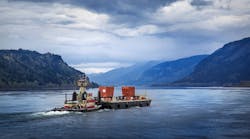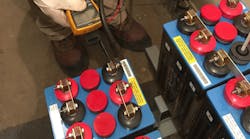The Northwest transmission grid took a big step into the future today with the $370 million modernization of a one-of-a-kind piece of infrastructure, the Celilo Converter Station.
BPA Administrator Elliot Mainzer called Celilo’s return to commercial operation “an important moment for infrastructure development in the region.” Construction began in the fall of 2014, and the station had been out of service since October for final installation and comprehensive testing of its customized new equipment.
The unique converter station, owned by the Bonneville Power Administration, tames and transforms high volumes of electricity flowing through the northern end of the Pacific Direct Current Intertie. The 846-mile electron super-highway, the longest commercial transmission line of its kind in the nation, connects the Northwest with the Los Angeles Department of Water and Power at Sylmar, Calif. The intertie provides affordable energy, reliability and cost benefits to customers at either end, and the electricity that flows from north to south is virtually carbon-free.
BPA, which funded the improvements, is also in the process of upgrading the 265-mile portion of intertie that it owns from the Columbia River to the Nevada-Oregon border.
“I am very proud of the talent and teamwork demonstrated by BPA and our partners that enabled us to hit this milestone so safely and successfully,” Mainzer said. “Thanks to their ingenuity and dedication, a unique but aging collection of 20th-century technology has been transformed into a state-of-the-art asset to serve the Northwest and beyond for many years to come.”
The modernization of the converter station – including six massive new transformers, each weighing more than a Boeing 747 airliner – anchors a $498 million package of BPA-funded grid upgrades to the northern leg of the PDCI. When the final phase of the overall project is completed this fall, the BPA transmission-line upgrades will raise the capacity of the intertie from 3,100 to 3,220 megawatts.
“BPA and its partners completed the work on this complex and challenging project on time and on budget, while achieving an outstanding safety record,” said Richard Shaheen, BPA senior vice president of Transmission Services. “These significant steps to improve the backbone of the regional grid will both strengthen reliability and increase our capacity to deliver energy, contributing to the vitality of the Northwest. It’s a great example of our strategic focus to ensure the long-term health and operational efficiency of our physical assets.”
Deputy Secretary of Energy Elizabeth Sherwood-Randall said, “The Department of Energy commends the effective partnership among Bonneville Power Administration, its contractors and its Southwest utility partners in enhancing a major transmission link in the West. This accomplishment is an example of the types of infrastructure advancement that will help the region and our nation maintain economic vitality in a changing energy market.”
The Pacific Direct Current Intertie, a high-voltage direct current system (HVDC), was a marvel and a model when it was energized in 1970. Direct-current systems can move large amounts of electricity over long distances more efficiently than alternating current lines of a similar length because less power is lost to the air as heat along the way.
That electrical feat, and the intricate technology that supports it, attracts utility representatives, government officials and business people from as far away as Africa and Asia to visit Celilo. But after more than four decades of vigorous, dependable service, the vintage equipment at the converter station had far surpassed its operational life span and was due for a transformation of its own.
“The new equipment not only supports the western transmission grid with greater security, reliability, capacity and flexibility, but will be able to work harder,” Shaheen added. Keeping the previous equipment in safe operating condition required shutting down the intertie for several weeks of maintenance each year. The next-generation equipment, much of it digital, needs far less routine upkeep, reducing outages and costs while improving performance for customers.
“The Pacific Direct Current Intertie has a great value for the entire West,” said Mukhles Bhuiyan, manager of grid planning and development at the Los Angeles Department of Water and Power. “We appreciate BPA’s leadership and investment in modernizing the northern anchor of our mutual resource.”


